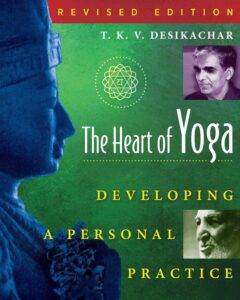Yoga involves physical poses, controlled breathing, and meditation to boost overall wellness. Whether you’re a beginner or an experienced practitioner, these 6 best books on yoga offer invaluable knowledge and practical advice to deepen your practice.
1.“Light on Yoga” by B.K.S. Iyengar
Overview: This classic book by B.K.S. Iyengar is often known as the “Bible of modern yoga.” It provides comprehensive guidance on yoga postures (asanas), breathing techniques (pranayama), and the philosophy of yoga.
Why You Should Read It: “Light on Yoga” is a must-read for anyone serious about yoga. It offers detailed instructions, illustrations, and the benefits of each pose, making it an essential reference for practitioners of all levels.
Key Takeaways:
- Guidance on performing over 200 yoga postures.
- Detailed explanations of breathing techniques.
- Insights into yoga philosophy and principles.
- Practical tips for developing a consistent practice.
2.“The Heart of Yoga” by T.K.V. Desikachar
Overview: Written by T.K.V. Desikachar, son of the legendary yogi T. Krishnamacharya, this book offers a practical approach to yoga tailored to individual needs. It emphasizes the importance of adapting the practice to suit each person’s unique body and life circumstances.
Why You Should Read It: “The Heart of Yoga” provides a holistic understanding of yoga, integrating physical practice with breath control and meditation. It’s perfect for those looking to develop a personalized yoga practice.
Key Takeaways:
- Steps to create a custom yoga routine.
- Focus on the breath-movement connection.
- Overview of the Yoga Sutras of Patanjali.
- Advice on incorporating yoga into daily life
3.“The Yoga Sutras of Patanjali” by Swami Satchidananda
Overview: This book is a translation and commentary on the Yoga Sutras, a foundational text of yoga philosophy. Swami Satchidananda’s interpretation makes these ancient teachings accessible and relevant to modern practitioners.
Why You Should Read It: Understanding the Yoga Sutras is essential for anyone interested in the deeper aspects of yoga. This book offers clear explanations and practical insights into the philosophy that underpins the practice.
Key Takeaways:
- In-depth explanation of the Yoga Sutras.
- Insights into the eight limbs of yoga.
- Practical advice for applying the teachings in daily life.
- Focus on the mental and spiritual dimensions of yoga.
4.“The Key Muscles of Yoga” by Ray Long
Overview: This book integrates anatomy with yoga to explain how the body functions in different postures. Ray Long’s clear illustrations and explanations make it an invaluable resource for yoga practitioners and teachers.
Why You Should Read It: “The Key Muscles of Yoga” helps you understand the anatomical aspects of yoga, enhancing your practice and preventing injuries. It’s useful for those interested in the science behind the poses.
Key Takeaways:
- Comprehensive body illustrations and explanations
- Insights into the muscles involved in each pose.
- Tips for improving alignment and preventing injuries.
- Practical applications of anatomy to yoga practice.
5.“Yoga Anatomy” by Leslie Kaminoff and Amy Matthews
Overview: “Yoga Anatomy” provides a comprehensive look at the structures and principles underlying each movement in yoga. The book features detailed anatomical drawings and in-depth information on how different poses affect the body.
Why You Should Read It: This book is essential for those who want to deepen their understanding of the anatomical principles of yoga. It offers practical insights that can enhance both your practice and teaching.
Key Takeaways:
- Detailed anatomical drawings of yoga poses.
- Explanations of the physical and energetic aspects of each pose.
- Practical advice for improving posture and alignment.
- Insights into the breath and its role in yoga practice.
6.“The Art of Vinyasa” by Richard Freeman and Mary Taylor
Overview: This book explores the practice of Ashtanga yoga, focusing on the principles of Vinyasa, or breath-synchronized movement. Richard Freeman and Mary Taylor offer insights into the philosophical and practical aspects of Ashtanga yoga.
Why You Should Read It: “The Art of Vinyasa” is perfect for those practicing or interested in Ashtanga yoga. It provides a deep understanding of the practice’s foundations and offers guidance on integrating these principles into your life.
Key Takeaways:
- Explanation of Vinyasa and its importance in yoga.
- Insights into the philosophy and principles of Ashtanga yoga.
- Practical advice for developing a consistent practice.
- Tips for integrating breath and movement.
Additional Tips for Yoga Practice Success
- Regular Practice: Consistent practice is essential to gain the full benefits of yoga.
- Listen to Your Body: Respect your body’s limits and avoid pushing too hard.
- Focus on Breath: Integrate breath control into your practice to enhance relaxation and focus.
- Create a Calm Space: Practice in a quiet, comfortable environment.
- Stay Hydrated: Drink plenty of water to keep your body hydrated.
FAQs
Q1: How do I choose the best book for my yoga journey?
A1: Consider your goals and interests. For foundational knowledge, “Light on Yoga” is excellent. For anatomical insights, “Yoga Anatomy” is ideal.
Q2: Can these books help with meditation and mindfulness?
A2: Yes, many of these books include guidance on meditation and the mental aspects of yoga.
Q3: Are these books suitable for beginners?
A3: Absolutely, these books offer valuable insights and guidance for practitioners at all levels, including beginners.
Conclusion
Deepening your yoga practice requires a combination of proper guidance, consistency, and mindfulness. These six best books on yoga provide the knowledge and tools you need to enhance your practice and improve your overall well-being. By incorporating the teachings from these books, you can develop a more profound and rewarding yoga journey






